Research in Meteorological Modeling Oriented Comprehensive Surface Complexity (CSC)
Abstract
1. Introduction
2. Study Area and Data
2.1. Study Area
2.2. Topographic and LULC Data
3. Comprehensive Surface Complexity Maps
3.1. Research Method
3.2. CSC Metrics and Analysis
3.2.1. CSC Metrics
3.2.2. Window Size Effect Analysis
4. Application of CSC in Meteorological Modeling
5. Discussion and Conclusions
5.1. Discussion
5.2. Conclusions
Author Contributions
Funding
Acknowledgments
Conflicts of Interest
References
- Smith, M.W. Roughness in the Earth Sciences. Earth Sci. Rev. 2014, 136, 202–225. [Google Scholar] [CrossRef]
- Berti, M.; Corsini, A.; Daehne, A. Comparative analysis of surface roughness algorithms for the identification of active landslides. Geomorphology 2013, 182, 1–18. [Google Scholar] [CrossRef]
- Baldo, E.; Margulis, S.A. Assessment of a multiresolution snow reanalysis framework: A multidecadal reanalysis case over the upper Yampa River basin, Colorado. Hydrol. Earth Syst. Sci. 2018, 22, 3575–3587. [Google Scholar] [CrossRef]
- Cao, M.; Zhu, Y.; Quan, J.; Zhou, S.; Lü, G.; Chen, M.; Huang, M. Spatial sequential modeling and predication of global land use and land cover changes by integrating a global change assessment model and cellular automata. Earth’s Future 2019. [Google Scholar] [CrossRef]
- Cao, M.; Huang, M.; Xu, R.; Lü, G.; Chen, M. A grey wolf optimizer–cellular automata integrated model for urban growth simulation and optimization. Trans. GIS. 2019. [Google Scholar] [CrossRef]
- Mukherjee, S.; Mukherjee, S.; Garg, R.D.; Bhardwaj, A.; Raju, P.L.N. Evaluation of topographic index in relation to terrain roughness and DEM grid spacing. J. Earth Syst. Sci. 2013, 122, 869–886. [Google Scholar] [CrossRef]
- Li, C.; Wang, Q.; Shi, W.; Zhao, S. Uncertainty modelling and analysis of volume calculations based on a regular grid digital elevation model (DEM). Comput. Geosci. 2018, 114, 117–129. [Google Scholar] [CrossRef]
- Carvalho, J.C.; Anfossi, D.; Castelli, S.T.; Degrazia, G.A. Application of a model system for the study of transport and diffusion in complex terrain to the TRACT experiment. Atmos. Environ. 2002, 36, 1147–1161. [Google Scholar] [CrossRef]
- Simova, P.; Gdulova, K. Landscape indices behavior: A review of scale effects. Appl. Geogr. 2012, 34, 385–394. [Google Scholar] [CrossRef]
- Zhai, Y.; Qu, Z.; Hao, L. Land Cover Classification Using Integrated Spectral, Temporal, and Spatial Features Derived from Remotely Sensed Images. Remote Sens. 2018, 10, 383. [Google Scholar] [CrossRef]
- Cao, M.; Zhu, Y.; Lü, G.; Chen, M.; Qiao, W. Spatial distribution of global cultivated land and its variation between 2000 and 2010, from both agro-ecological and geopolitical perspectives. Sustainability 2019, 11, 1242. [Google Scholar] [CrossRef]
- Zhao, C.; Sander, H.A. Assessing the sensitivity of urban ecosystem service maps to input spatial data resolution and method choice. Landsc. Urban Plan. 2018, 175, 11–22. [Google Scholar] [CrossRef]
- Miller, J.D.; Brewer, T. Refining flood estimation in urbanized catchments using landscape metrics. Landsc. Urban Plan. 2018, 175, 34–49. [Google Scholar] [CrossRef]
- Zhang, C.; Chen, M.; Li, R.; Fang, C.; Lin, H. What’s going on about geo-process modeling in virtual geographic environments. Ecol. Model. 2016, 319, 147–154. [Google Scholar] [CrossRef]
- Lü, G.; Batty, M.; Strobl, J.; Lin, H.; Zhu, A.X.; Chen, M. Reflections and speculations on the progress in Geographic Information Systems (GIS): A geographic perspective. Int. J. Geogr. Inf. Sci. 2019, 33, 346–367. [Google Scholar] [CrossRef]
- Goodchild, M.F. Scale in GIS: An overview. Geomorphology 2011, 130, 5–9. [Google Scholar] [CrossRef]
- Zhang, C.; Lin, H.; Chen, M.; Li, R.; Zeng, Z. Scale compatibility analysis in geographic process research: A case study of a meteorological simulation in Hong Kong. Appl. Geogr. 2014, 52, 135–143. [Google Scholar] [CrossRef]
- Zhang, C.; Lin, H.; Chen, M.; Yang, L. Scale matching of multiscale digital elevation model (DEM) data and the Weather Research and Forecasting (WRF) model: A case study of meteorological simulation in Hong Kong. Arab. J. Geosci. 2014, 7, 2215–2223. [Google Scholar] [CrossRef]
- Li, J.; Zheng, X.; Zhang, C.; Chen, Y. Impact of Land-Use and Land-Cover Change on Meteorology in the Beijing–Tianjin–Hebei Region from 1990 to 2010. Sustainability 2018, 10, 176. [Google Scholar] [CrossRef]
- Peng, J.; Ma, J.; Liu, Q.; Liu, Y.; Li, Y.; Yue, Y. Spatial-temporal change of land surface temperature across 285 cities in China: An urban-rural contrast perspective. Sci. Total Environ. 2018, 635, 487–497. [Google Scholar] [CrossRef]
- CGIAR-CSI. SRTM 90m Digital Elevation Data. 2012. Available online: http://srtm.csi.cgiar.org/index.asp (accessed on 21 August 2012).
- Liu, J.; Kuang, W.; Zhang, Z.; Xu, X.; Qin, Y.; Ning, J.; Wan, C.; Zhou, S.W.; Zhang, R.D.; Li, C.Z.; et al. Spatiotemporal characteristics, patterns, and causes of land-use changes in China since the late 1980s. J. Geogr. Sci. 2014, 24, 195–210. [Google Scholar] [CrossRef]
- Wang, J.; Feng, J.; Yan, Z. Potential sensitivity of warm season precipitation to urbanization extents: Modeling study in Beijing-Tianjin-Hebei urban agglomeration in China. J. Geophys. Res. Atmos. 2015, 120, 9408–9425. [Google Scholar] [CrossRef]
- Lane, S.N. Roughness-time for a re-evaluation? Earth Surf. Process. Landf. 2005, 30, 251–253. [Google Scholar] [CrossRef]
- Liu, R.; Han, Z.; Wu, J.; Hu, Y.; Li, J. The impacts of urban surface characteristics on radiation balance and meteorological variables in the boundary layer around Beijing in summertime. Atmos. Res. 2017, 197, 167–176. [Google Scholar] [CrossRef]
- Muro, J.; Strauch, A.; Heinemann, S.; Steinbach, S.; Thonfeld, F.; Waske, B.; Diekkrüger, B. Land surface temperature trends as indicator of land use changes in wetlands. Int. J. Appl. Earth Obs. Geoinf. 2018, 70, 62–71. [Google Scholar] [CrossRef]
- Abrantes, P.; Rocha, J.; Marques da Costa, E.; Gomes, E.; Morgado, P.; Costa, N. Modelling urban form: A multidimensional typology of urban occupation for spatial analysis. Environ. Plan. B Urban Anal. City Sci. 2017, 46, 1–19. [Google Scholar] [CrossRef]
- Almeida, D.; Rocha, J.; Neto, C.; Arsénio, P. Landscape metrics applied to formerly reclaimed saltmarshes: A tool to evaluate ecosystem services? Estuar. Coast. Shelf Sci. 2016, 181, 100–113. [Google Scholar] [CrossRef]

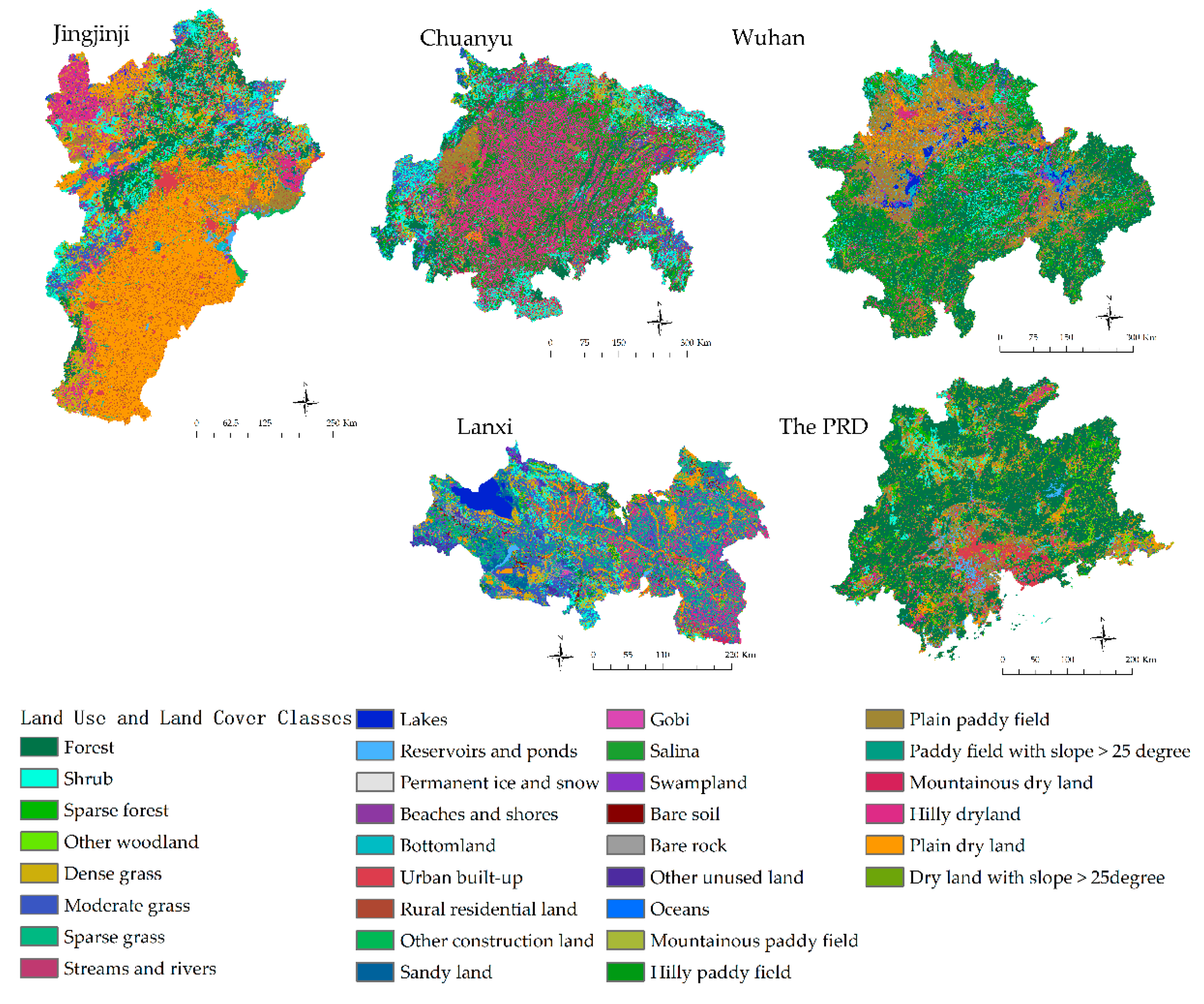

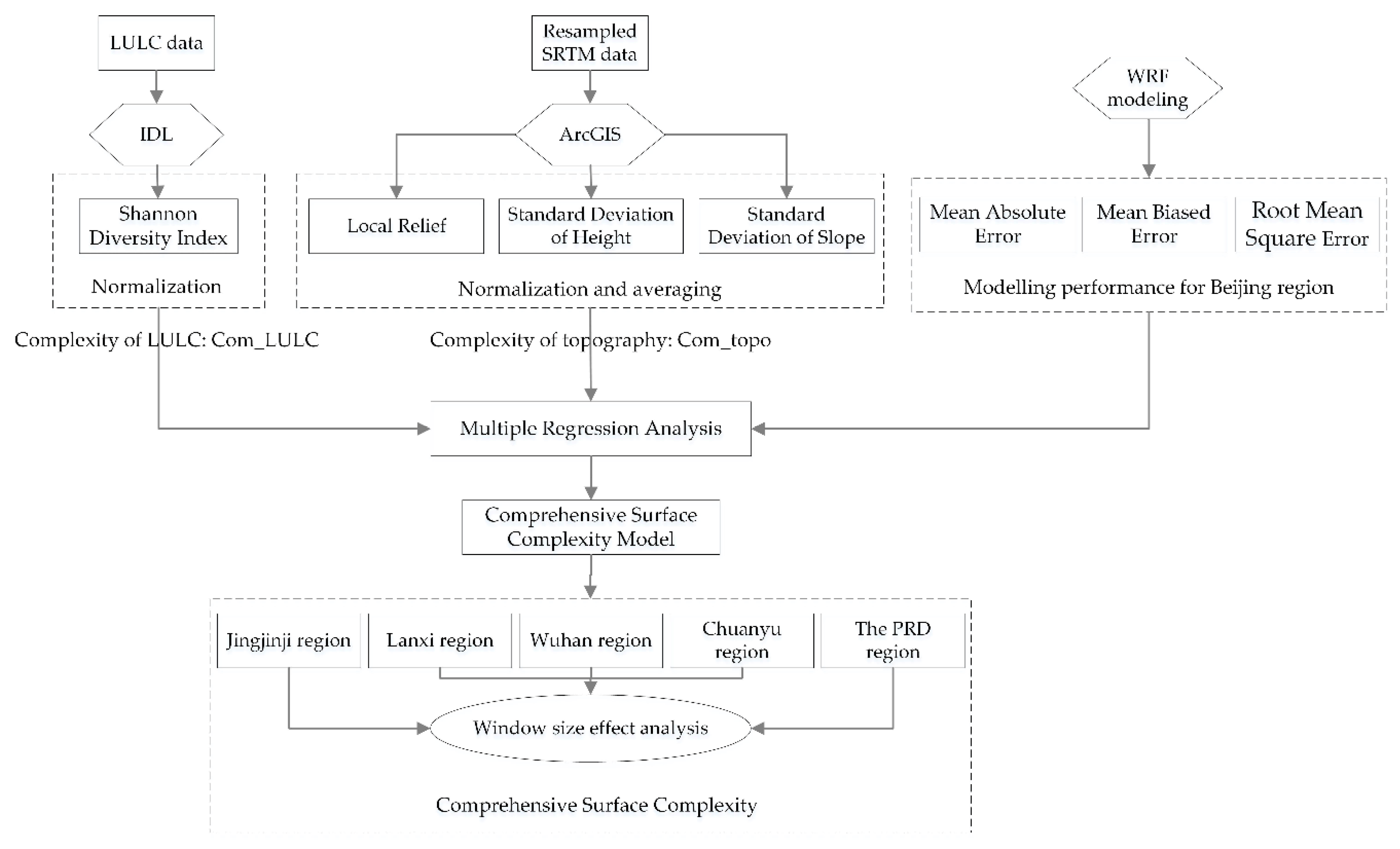
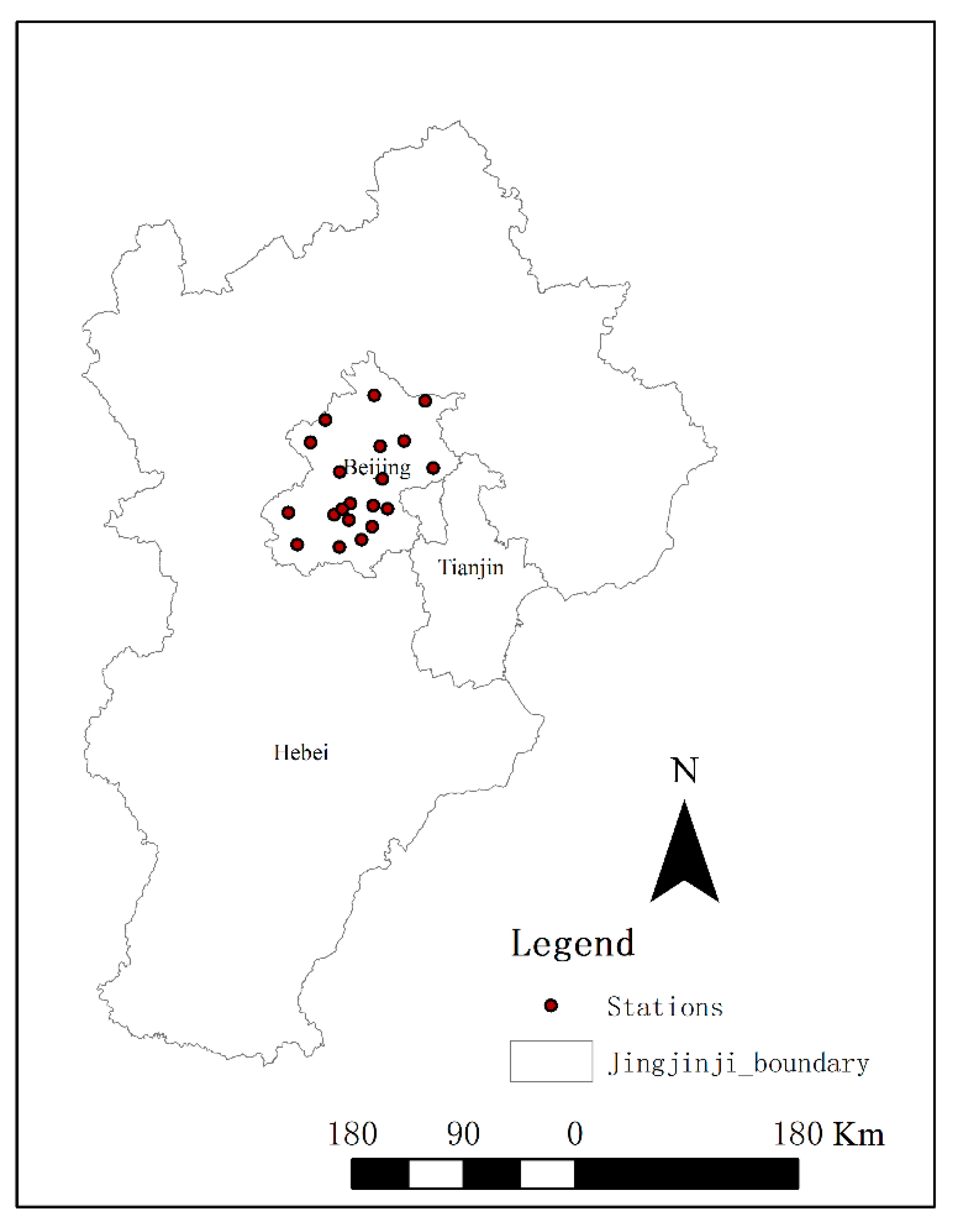
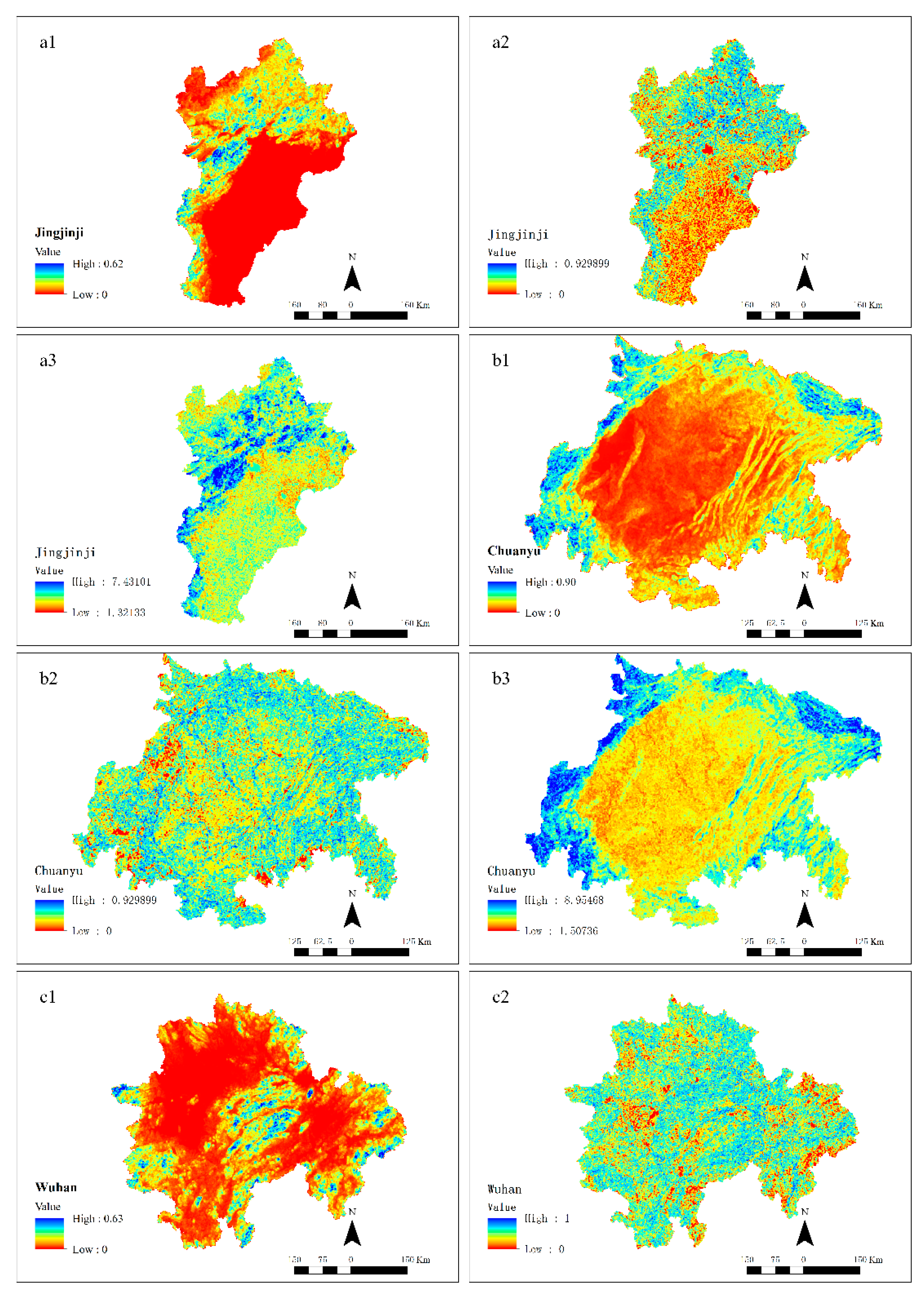
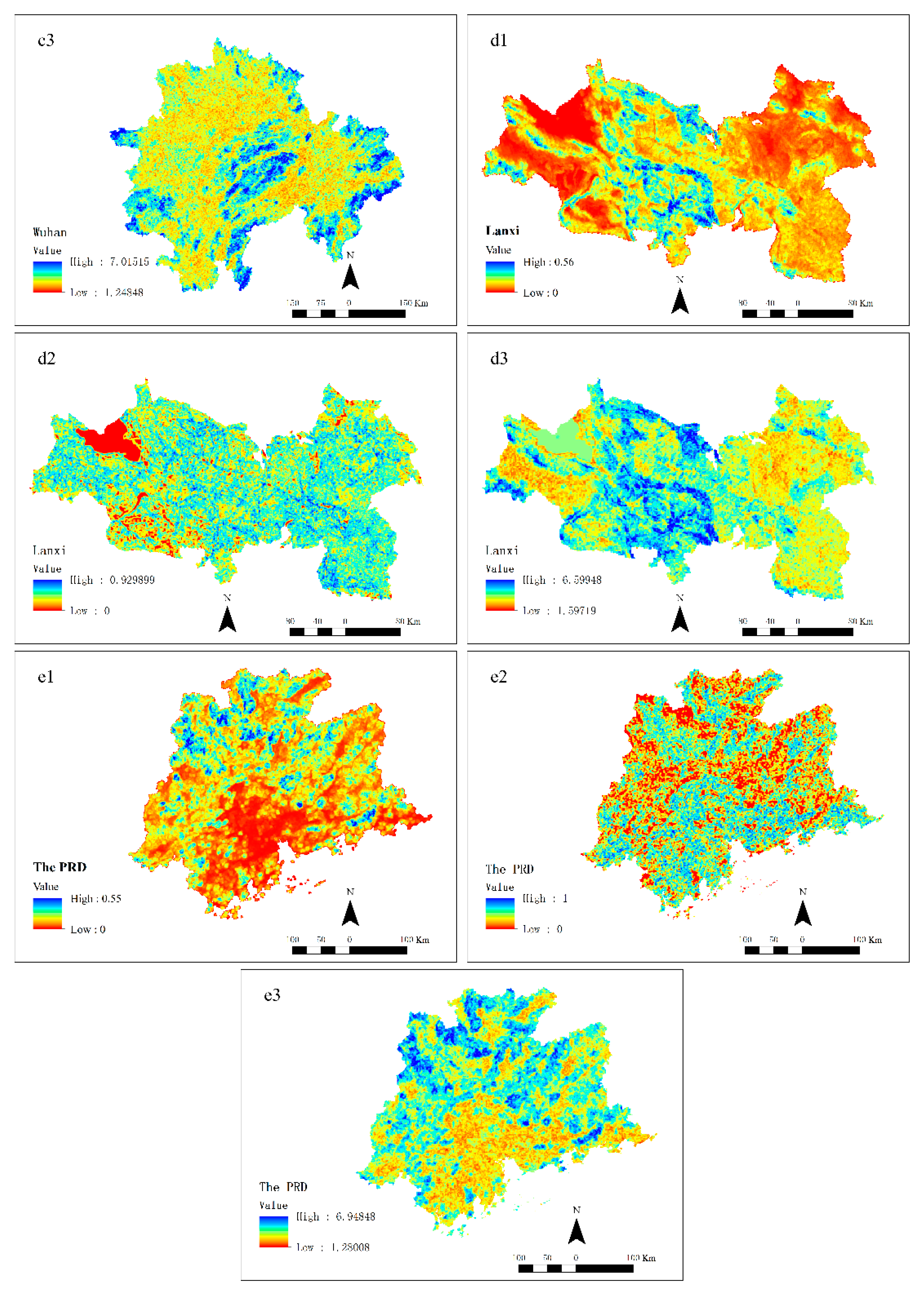
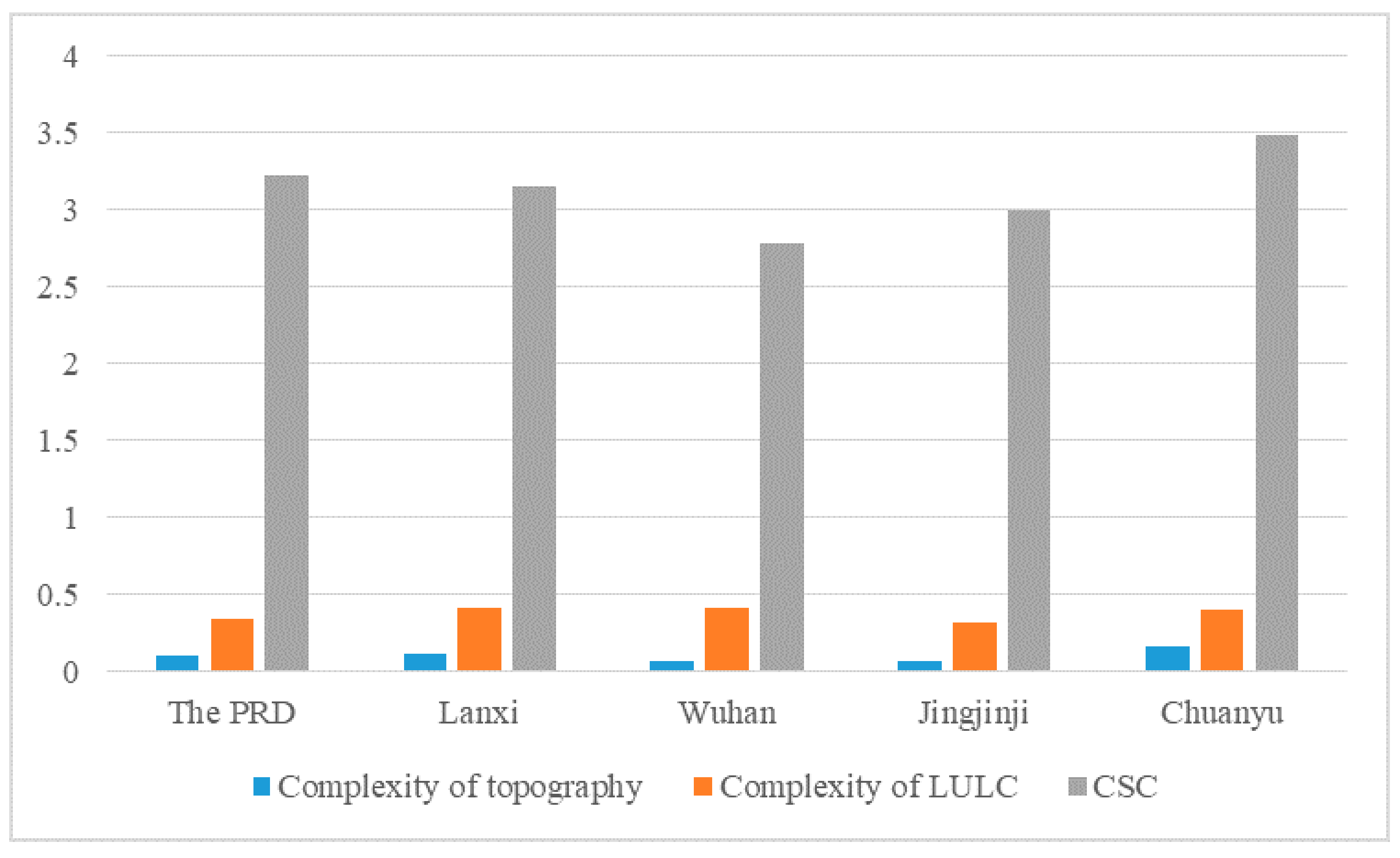
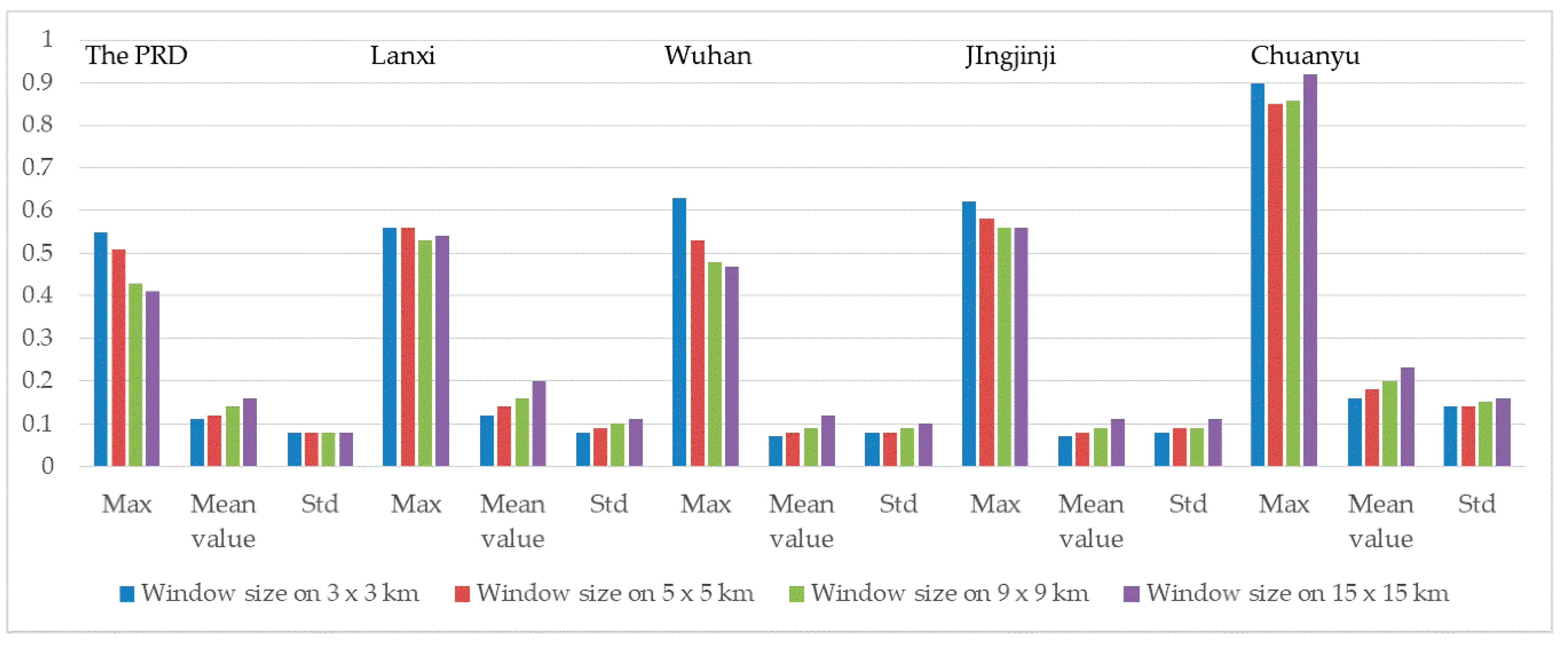
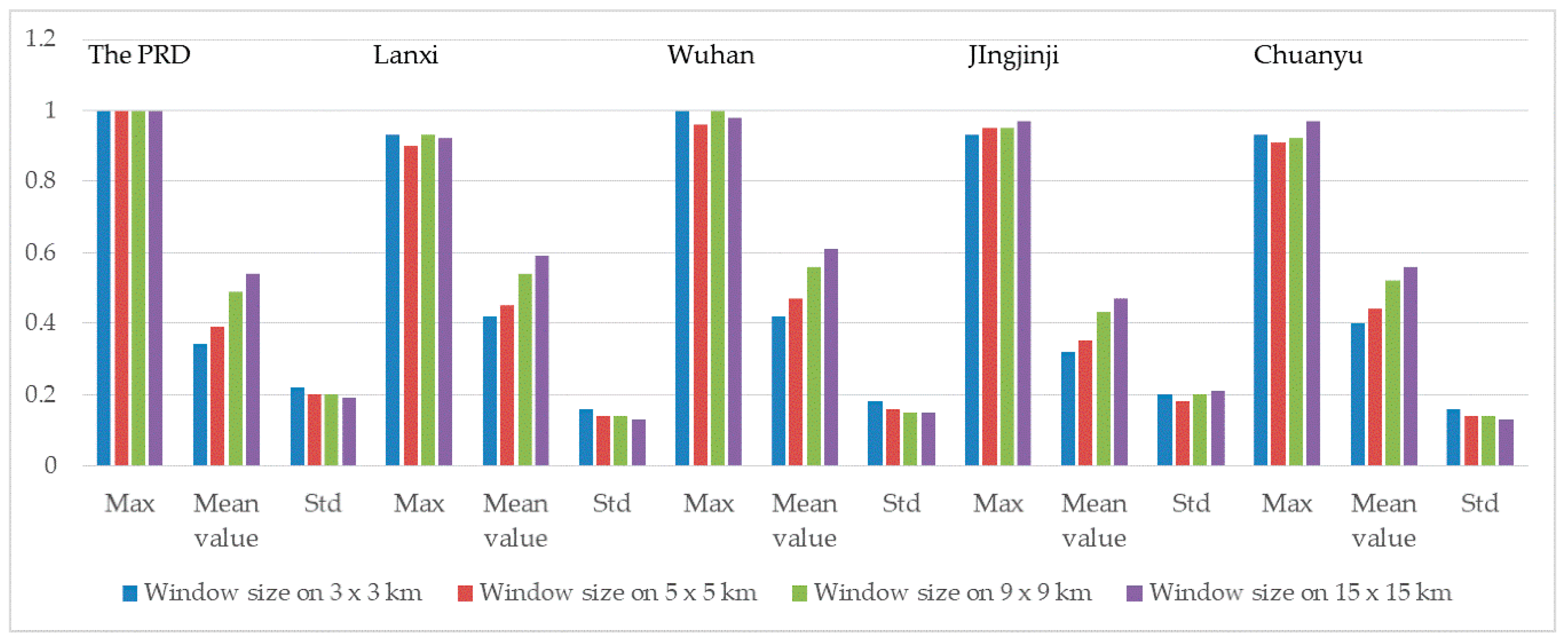

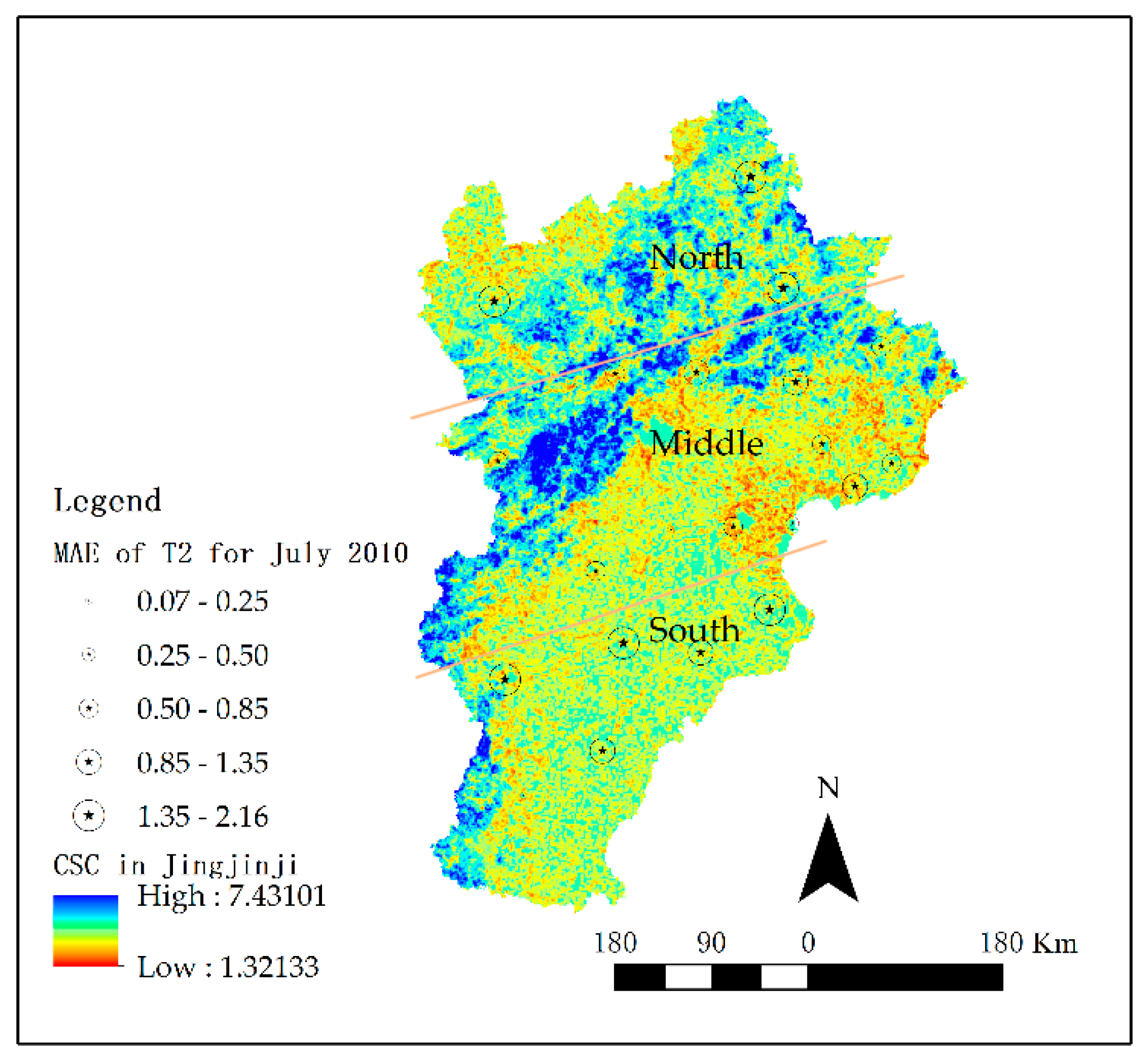
| Descriptor/Metric | Equation | Parameters | Range |
|---|---|---|---|
| Shannon’s diversity index (SHDI) | = proportion of the landscape occupied by LULC type i. | SHDI ≥ 0, without limit | |
| Local relief (LR) | H is the height of any point in a moving window | LR ≥ 0, without limit | |
| Standard deviation of height (SDH) | is the height of any point in a moving window and N is the number of points in a moving window | SDH ≥ 0, without limit | |
| Standard deviation of slope (SDS) | is the slope of any point in a moving window and N is the number of points in a moving window | SDS ≥ 0, without limit |
| MAE | MBE | RMSE | |
|---|---|---|---|
| Intercept | 3.15 | 3.15 | 3.56 |
| Complexity of LULC | −1.99 | −2.37 | −1.78 |
| Complexity of topography | 6.88 | 7.09 | 7.13 |
| Multiple R | 0.45 | 0.43 | 0.46 |
© 2019 by the authors. Licensee MDPI, Basel, Switzerland. This article is an open access article distributed under the terms and conditions of the Creative Commons Attribution (CC BY) license (http://creativecommons.org/licenses/by/4.0/).
Share and Cite
Zhang, C.; Zheng, X.; Li, J.; Wang, S.; Xu, W. Research in Meteorological Modeling Oriented Comprehensive Surface Complexity (CSC). Sustainability 2019, 11, 4081. https://doi.org/10.3390/su11154081
Zhang C, Zheng X, Li J, Wang S, Xu W. Research in Meteorological Modeling Oriented Comprehensive Surface Complexity (CSC). Sustainability. 2019; 11(15):4081. https://doi.org/10.3390/su11154081
Chicago/Turabian StyleZhang, Chunxiao, Xinqi Zheng, Jiayang Li, Shuxian Wang, and Weiming Xu. 2019. "Research in Meteorological Modeling Oriented Comprehensive Surface Complexity (CSC)" Sustainability 11, no. 15: 4081. https://doi.org/10.3390/su11154081
APA StyleZhang, C., Zheng, X., Li, J., Wang, S., & Xu, W. (2019). Research in Meteorological Modeling Oriented Comprehensive Surface Complexity (CSC). Sustainability, 11(15), 4081. https://doi.org/10.3390/su11154081







